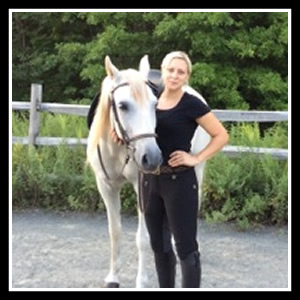Dressage Secrets: Outside Leg

Hi this is Will Faeber from Art2Ride with my lovely wife Karen Loshbaugh and we are going to tell you about one of the secrets of dressage. In an earlier video we talked about how the legs are used and how the leg can be used to make the horse move sideways, straight forward or when we come underneath to engage the horse’s back. One of the things that most people have wrong when I see their position is the outside leg. The outside leg is one of the keys to getting a horse to bend correctly.
Usually when I tell people to put the outside leg back, they usually swing the leg back from the knee and they think that means to put the leg back. What that does as you will feel when you try this at home is your seat bones will not change in the saddle. When you swing your leg back from the knee the seat bones basically stay right where they are. One of the secrets of dressage is getting the correct outside leg, and it is the single hardest thing in the position to achieve, because you literally have to have your outside leg back while your outside shoulder is forward.
What you want to happen when you try this at home is you want your knee to come away from the saddle a little bit and your leg to come back like the example shown in the video. The leg comes back from the hip and not the knee. Notice how the leg actually comes away from the block on the front of the saddle. What you will experience when you try this at home is the weight will automatically be shifted to your inside seat bones. Very often we see people trying to think about weighing seat bones but they don’t understand this element and wind up swinging their hips back and forth trying to get the weight on the inside seat bone and they start leaning off to one side or the other. So once again, your hips should always stay square in the saddle and should never twist in the saddle. We don’t want to exaggerate this to the point of this where all of a sudden your hips are out of position, it is just here (as shown in video) while you are stretching up tall and straight. You are simply going to bring the leg back from the hip as shown in the video.
There are three basic positions that I call neutral positions of the aids, the positions at which you do everything else. These are neutral positions, which means there is no tension. The parallel position: Anytime the horse is going straight you have both legs at the girth or back behind the girth a little bit. Left diagonal position (anytime you are bent to the left): Your outside leg is going to be back from the hip while your outside shoulder comes forward. Look how I have created a channel here (in video), it automatically creates a channel so you can send the horse down. It is just like sending water down a bent pipe so to speak, it will curve around, as will a horse when it is starting to flow. Right diagonal position (anytime you are bent to the right): Your outside leg is back with your outside shoulder slightly forward (You are not twisted around, it’s just a little and it feels natural). Once again your three basic positions or neutral positions are: Parallel, left diagonal and right diagonal.
Your aids will be relaxed in these positions until you need it. If the horse swings his hind quarters over, you are going to use your outside leg. If you need to move him over into your outside rein, it’s going to be your inside leg. Once again, one of the biggest secrets of dressage is the correct position of the outside leg, moving it back from the hip and not from the knee. Thank you so much and we hope this helps! This is Will Faeber and Karen Loshbaugh from Art2Ride.
3 responses to “Dressage Secrets: Outside Leg”
Leave a Reply
Thanks again for sharing your helpful advice. I did some work this past weekend, and noticed my horse just about wrapped herself around my inside leg once my outside leg was correctly applied. It’s great to make progress!
First time I see a clear explanation on this subject. Thanks a lot. So many years without anybody able to tell me things in this clear way. Thanks again.
Thank you for such a clear helpful explanation





Thanks again for sharing your helpful advice. I did some work this past weekend, and noticed my horse just about wrapped herself around my inside leg once my outside leg was correctly applied. It’s great to make progress!
First time I see a clear explanation on this subject. Thanks a lot. So many years without anybody able to tell me things in this clear way. Thanks again.
Thank you for such a clear helpful explanation